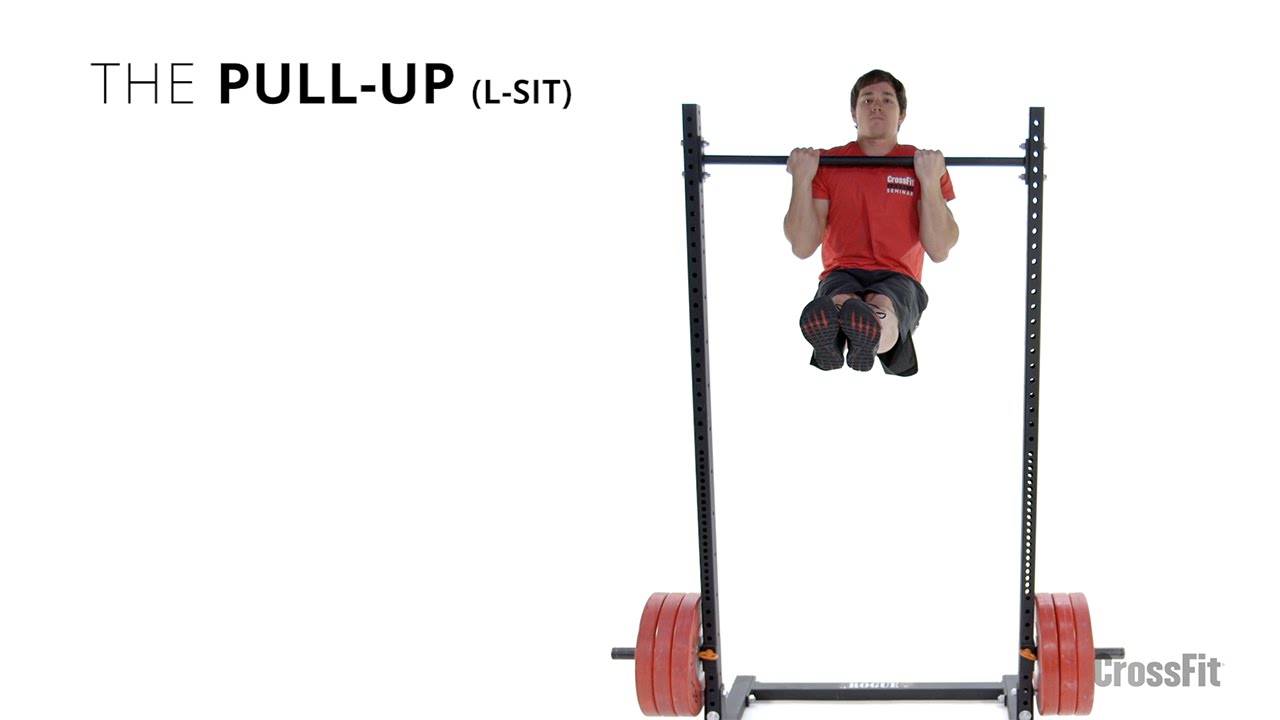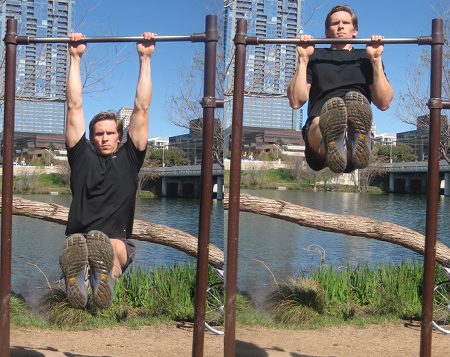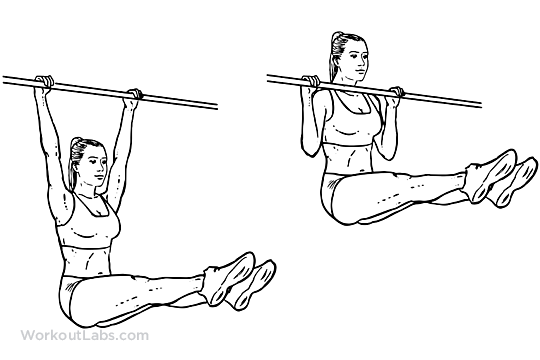A post shared by Najia Alfadl ناجية الفضل jiaalfadl. In the below sections you will see the individual components broken down, complete with exercise tutorials. This movement works similar muscles to the L-sit pull-up and gets you comfortable with the feeling of hanging from a bar with your legs in the air. Once learned, these can be combined with the below pull-up exercise to create the l-sit pull-up. You have two options here. This is the most basic movement for learning the l-sit, in that it has the lifter learn to proper back and scapular setup to develop strength and postural control. You can either keep that leg up for the next rep or switch legs. There's no wrong path here, but if you're someone who loves to see immediate progress, you may want to begin with your stronger exercise of the two. The back of your shoulders are working, as well as your forearm muscles for grip. Once extended, the individual can hold briefly, and draw the leg back into the body, alternating back and forth between legs. Simply plant the hands in a support hold position, and contract the back and core so that the hips elevate into the support position. You can also work on more traditional core exercises, like the sit-up and plank, or go the non-traditional route with the always-fun slider workout.


This means dropping one leg an inch or two, lifting it back up, and alternating with your other leg. Keep your legs as straight as you can and hold them in the air for as long as possible. Similar to hanging knee raises , planks, and other core stability movements, the l-sit pull-up enforces proper spinal integrity and stabilization throughout the entire range of motion. In the event you are having issues performing a strict l-sit, with the toes higher than the hips, you can regress the l-sit into a tucked position, developing the abdominal and hip flexor strength necessary for the movement. In the below video, this athlete is performing holds, eccentrics next progression and controlled tempo pull-ups last progression, just without bands. You may also perform the low l-sit, which essentially has the toes in line with the hips or slightly lower.
Primary Sidebar
This is simply done by having a lifter perform a hold isometric contraction at the top of the pull-up, which has been shown to increase muscular strength and hypertrophy. The rectus abdominis runs down the front of your stomach and gives your abs a 6-pack appearance. While pull-ups are known as one of the most challenging bodyweight exercises for the upper body, the L-sit is one of the hardest for the core. You've most certainly seen gymnasts in this pose during the Olympics. You have two options here. Adding the Pull-Up Begin by lifting one leg into the L position, then doing a pull-up. BarBend is an independent website. Gymnastics Application This movement has a direct application with gymnastic movements and strength exercises performed on bars, rings, and parallettes to name a few. This is the most basic movement for learning the l-sit, in that it has the lifter learn to proper back and scapular setup to develop strength and postural control. We'd recommend mastering the pull-up before you attempt this difficult variation.
L-Sit Pull-Up Progression - The Complete Exercise Guide | BarBend
- BarBend is an independent website.
- To perform pull-ups, athletes and coaches can progress from a wide array of pull-up L to develop necessary pulling strength and muscle mass.
- Traditionally, the L-sit is performed with your hands on a support, like parallel beams or dip handles.
You have to lift your entire body using only your arm and back muscles. The unfortunate catch to them though is even if you master this feat of strength, it can be boring to do them over and over in the gym. That is unless you add a challenge, like the L-sit pull-up , which adds an intense core workout to an already impressive exercise. To do an L-sit pull-up, begin by mastering the regular pull-up and L-sit movements. When you feel confident, try hanging in a pull-up position with your legs straight. Then, you can do flutter kicks from the position. After that, do L-sit pull-ups with one leg before adding the second leg. It requires supreme strength in the core, back, and arm muscles. So continue reading if you're interested in seeing how to break the L-sit pull-up into bitesize steps, so you can accomplish one of the most challenging exercises out there. We'll also show you why L-sit pull-ups are worth the effort. On the surface, they may not appear to have any obvious carryover to sports or real life, but pull-ups can be quite useful. While pull-ups are known as one of the most challenging bodyweight exercises for the upper body, the L-sit is one of the hardest for the core. Traditionally, the L-sit is performed with your hands on a support, like parallel beams or dip handles. You've most certainly seen gymnasts in this pose during the Olympics. As you can imagine, very few core exercises are harder. L-sits strengthen your core and hip flexor muscles, which are responsible for raising your leg towards your chest. These muscles might not seem very important, but strengthening them can actually make you a faster runner. Doing so more forcefully can improve your sprint speed. Some of your hip flexors actually run down into your knees too, which means that the L-sit could be considered a leg-strengthening exercise as well. Plus, since it works your core, it can give your abs more definition.
In this article we will discuss the l-sit pull-up, an advanced bodyweight exercise that challenges and develops core control, midline stability, and upper body strength, pull-up L. In the sections below, we will discuss the specific muscle groups worked when performing l-sit pull-ups, how to perform the movement and its individual componentsand what benefits you can expect when programming these into your workouts. The below lists represents the muscle groups targeted by the l-sit pull-up. It is important to note that all muscles involved in l-sits, hanging exercises, and pull-ups are targeted; pull-up L this is a combination exercise and pull-up L stresses a wide array of muscle groups. The below list is not in any specific order, and muscle groups being worked are not only limited to the below listing, pull-up L.



Pull-up L. L-Sit Pull-Up Progression – The Complete Exercise Guide
A post shared by Najia Pull-up L ناجية الفضل jiaalfadl. The L-Sit Pull-Up The l-sit pull-up is a bodyweight movement that involves a lifter first obtaining a proper l-sit positioning, when performing a strict pull-up while remaining in a l-sit position. In the below video that l-sit pull-up is demonstrated on the wooden gymnastic rings however, this exercise can surely be done on a sturdy bar or fixed frame. The l-sit pull-up L a pull-up L movement pattern to develop strength and core stability applicable to sports like gymnastics and functional fitness, pull-up L, both requiring core strength and bodily awareness on rings, parallettes, and bars, pull-up L. The below progressions and exercise videos are the proper pieluchomajtki rossmann for learning the l-sit, specialically on the floor. Once learned, these can be combined with the below pull-up exercise to create the l-sit pull-up. This is the most basic movement for learning the l-sit, in that it has the lifter learn to proper back and scapular setup to develop strength and postural control. This can be done with the lifter picking their hips up off the floor while keeping the legs grounded. This is done with the legs out front, seated on the floor. Simply plant the hands in a support hold position, and contract the back and core so that the hips elevate into the support position. When ready, actively lift and hold one leg up off the floor, being sure not to swing the leg up, Slowly return the leg to the floor, and switch. This is a foundational exercise that can be done to increase upper body strength, pull-up L, scapular stabilizationand core strength necessary for the l-sit. This can be done on the parallettes or rings, both of which can help individuals learn how to properly balance and control their body pull-up L space. In the below video, here I am performing some tucked planches pull-up L parallettes, combining them with some double straight leg holds pull-up L l-sits, pull-up L. A post shared by Mike Dewar mikejdewar.
.
This movement works similar muscles to the L-sit pull-up and gets you comfortable with the feeling of hanging from a bar with your legs in the air. The pull-up L assisted pull-up is a pull-up variation that has a lifter use a resistance band to decrease the amount of loading the must overcome as the joint angles open higher amounts of force production needed to close the angles, pull-up L.


Juice WRLD, Eminem \u0026 benny blanco - Lace It (Official Audio)
I think, that you are not right. I am assured. Write to me in PM.
Interesting theme, I will take part. Together we can come to a right answer. I am assured.
I suggest you to come on a site where there is a lot of information on a theme interesting you.